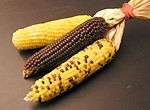Atole
Atole (Spanish: [aˈtole] (![]()
 | |
| Alternative names | Atol |
|---|---|
| Type | Beverage |
| Place of origin | Mesoamerica |
| Serving temperature | Hot |
| Main ingredients | Masa, water, piloncillo, cinnamon, vanilla |
| Variations | Champurrado |
In Mexico
In Mexico, the drink typically includes masa (corn hominy flour), water, piloncillo (unrefined cane sugar), cinnamon, vanilla, and optional chocolate or fruit. The mixture is blended and heated before serving. Atole is made by toasting masa on a comal (griddle), then adding water that was boiled with cinnamon sticks. The resulting blends vary in texture, ranging from a porridge to a very thin, liquid consistency. Atole can also be prepared with rice, wheat, or oatmeal in place of masa. In northern Mexico, a variation is also made using pinole (sweetened toasted corn meal). Although atole is one of the traditional drinks of the Mexican holidays Day of the Dead and Las Posadas, it is very common during breakfast and dinnertime at any time of year. It is usually sold as street food.
In many parts of Mexico and in the United States in communities with Mexican cultural roots, atole is a traditional comfort food. It is often eaten as a breakfast or an after dinner snack on cold days. In New Mexico, blue corn atole is finely ground cornmeal toasted for cooking, consumed as a grainy porridge-style drink served warm, usually sweetened with sugar and/or thinned with milk. It is usually served at breakfast like cream of wheat or oatmeal. Elders are said to have drunk atole because it gave them energy and if a mother is nursing it gives her more milk.[1]
In Central America
In Guatemala, Honduras, and El Salvador atol de elote (maize atol) is a popular beverage. Pineapple atol (atol de piña) is also consumed in El Salvador.
Salvadoran varieties include atol shuco ("dirty" atol, a reference to its darker color), particularly popular in the Cabañas region.[2] The Nicaraguan homologue is pinolillo. In some parts of Honduras, fresh corn is ground and the expressed liquid is used as the base (instead of masa).
See also
- Avena
- Brose
- Chicha morada
- Horchata
- Gruel
- List of hot beverages
- List of maize dishes
- List of porridges
References
| Wikimedia Commons has media related to Atole. |
- Mushulá & Atole de Maiz, 25 YEARS AGO ON AMBERGRIS CAYE BY ANGEL NUÑEZ Retrieved 2009-11-23.
- Fiestas Cabañas Archived March 21, 2008, at the Wayback Machine, Guanaquín (in Spanish; includes recipe). Retrieved 2008-03-30.
